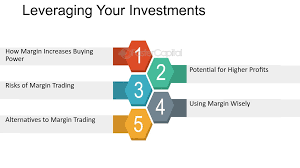Margin trading, an advanced investment strategy, has been utilized by traders to amplify their buying power. By borrowing money from a broker, investors can purchase more securities than they could with their available funds. This approach, while potentially lucrative, carries significant risks. This log will explore the mechanics, advantages, risks, and considerations associated with margin trading, providing a comprehensive understanding of this financial tool.
Mechanics of Margin Trading
Margin accounts, as opposed to regular cash accounts, are required for margin trading. In such accounts, the broker lends money to the investor to purchase securities. A minimum margin, or the percentage of the purchase price that must be covered by the investor’s own funds, is mandated by regulatory authorities. The initial margin requirement, set by the Federal Reserve in the United States, typically stands at 50%. This means that if an investor wishes to purchase $10,000 worth of stock, at least $5,000 must come from their own capital, while the remaining $5,000 can be borrowed.
Maintenance margin, another critical aspect, is the minimum account balance that must be maintained after the purchase. Should the value of the securities fall, and the equity in the account drops below this threshold, a margin call will be issued by the broker. The investor is then required to deposit more funds or sell some of the assets to restore the account to the minimum required level.
Advantages of Margin Trading
Increased buying power is the primary advantage of margin trading. By leveraging their investments, traders can potentially achieve higher returns than they could with only their own capital. For example, if a stock purchased on margin appreciates in value, the gains are realized on the entire position, not just the investor’s portion, thereby magnifying the profits.
Another benefit is the ability to diversify investments. By borrowing funds, investors can spread their capital across a broader range of securities, thereby reducing the risk associated with concentrating too much capital in a single investment.
Risks of Margin Trading
Despite its advantages, margin trading is fraught with risks. The most significant is the potential for magnified losses. Just as gains are amplified, so too are losses. If the value of the securities declines, the investor not only loses their own capital but also owes the borrowed funds to the broker, which can lead to significant financial distress.
Margin calls pose another substantial risk. When the value of the securities falls below a certain level, additional funds or securities must be provided by the investor to cover the margin call. Failure to meet this demand can result in the broker liquidating the investor’s assets at potentially unfavorable prices, leading to further losses.
Interest costs, often overlooked, can also erode profits. The borrowed funds are subject to interest charges, which accumulate over time. High-interest rates or extended holding periods can significantly impact the overall profitability of margin trades.
Considerations Before Engaging in Margin Trading
Understanding the complexities and risks of margin trading is crucial before engaging in it. Investors should evaluate their risk tolerance, investment goals, and financial situation. Margin trading is not suitable for all investors, particularly those with a low-risk appetite or limited financial resources.
A thorough knowledge of the terms and conditions of the margin account agreement is essential. Different brokers may have varying policies regarding margin requirements, interest rates, and margin calls. Being aware of these details can help investors make informed decisions and avoid unexpected surprises.
Utilizing risk management strategies, such as setting stop-loss orders, can mitigate some of the risks associated with margin trading. These orders automatically sell securities when they reach a certain price, thereby limiting potential losses. Regular monitoring of the account is also important to ensure that margin requirements are met and to respond promptly to any margin calls.
Leveraging Investments for Higher Returns in the Stock Market

The allure of achieving higher returns in the stock market has led many investors to consider leveraging their investments. Leverage, in the context of investing, involves using borrowed capital to increase the potential return of an investment. While the strategy can amplify gains, it also carries significant risks that must be managed carefully. This log will explore the principles of leveraging investments, the mechanisms available to investors, the benefits, the inherent risks, and strategies to mitigate those risks.
Principles of Leveraging Investments
Leverage is achieved by using financial instruments or borrowed funds to increase the potential return on an investment. Essentially, it allows an investor to control a larger position than they could with their own capital alone. The concept is rooted in the idea that the returns generated from the borrowed funds will exceed the cost of borrowing.
The leverage ratio is a key concept, representing the ratio of borrowed funds to the investor’s own equity. For instance, a leverage ratio of 2:1 means that for every dollar of the investor’s own money, two dollars are invested, with one dollar borrowed. This amplifies both potential gains and potential losses.
Mechanisms of Leverage
Several mechanisms are available to investors to leverage their investments:
- Margin Trading: This involves borrowing money from a broker to purchase more securities than could be bought with available cash. The securities themselves often serve as collateral for the loan. Margin accounts allow investors to leverage their positions, potentially increasing returns. However, margin calls can occur if the value of the securities falls below a certain level, requiring the investor to deposit more funds or sell assets.
- Options: Options are derivatives that provide the right, but not the obligation, to buy or sell an asset at a predetermined price before a specified date. By paying a premium, investors can control a larger amount of stock, thus leveraging their position. Calls and puts are the two primary types of options, used to speculate on the direction of stock prices.
- Futures Contracts: Futures are agreements to buy or sell an asset at a future date for a price agreed upon today. These contracts are often used to hedge risk but can also be employed to speculate with leverage. Futures contracts require a margin deposit, which can result in significant leverage.
- Leveraged ETFs: Exchange-traded funds (ETFs) that use financial derivatives and debt to amplify the returns of an underlying index are known as leveraged ETFs. These funds are designed to achieve multiples of the performance of the underlying index, often on a daily basis.
Benefits of Leverage
The primary benefit of leveraging investments is the potential for higher returns. By using borrowed funds, investors can increase their exposure to assets that are expected to perform well. If the investments do indeed rise in value, the gains are magnified compared to an unleveraged position.
Leverage can also allow investors to diversify their portfolios more effectively. With more capital at their disposal, they can spread their investments across a wider range of assets, potentially reducing risk.
Additionally, certain tax advantages might be associated with leveraging, such as the ability to deduct interest expenses on borrowed funds from taxable income, though this depends on individual circumstances and tax laws.
Risks of Leverage
The use of leverage introduces significant risks. The most apparent risk is the potential for amplified losses. Just as leverage can magnify gains, it can also magnify losses. If the value of the leveraged investment decreases, the losses incurred can exceed the initial investment, leading to significant financial strain.
Market volatility is another critical risk factor. Leveraged positions are highly sensitive to market fluctuations. A sudden downturn can trigger margin calls, forcing investors to liquidate assets at unfavorable prices.
Interest rate risk must also be considered. The cost of borrowing is influenced by prevailing interest rates. An increase in interest rates can raise the cost of leverage, thereby reducing net returns.
Risk Mitigation Strategies
Several strategies can be employed to mitigate the risks associated with leveraging investments:
- Setting Limits: Investors should establish clear limits on the amount of leverage used. This can involve setting a maximum leverage ratio or limiting the portion of the portfolio that is leveraged.
- Diversification: Spreading investments across various asset classes and sectors can help reduce the impact of a downturn in any single investment.
- Stop-Loss Orders: Implementing stop-loss orders can protect against significant losses by automatically selling a security when it reaches a predetermined price.
- Regular Monitoring: Continuously monitoring the performance of leveraged investments and the broader market conditions is essential. This allows investors to make timely adjustments to their positions.
- Stress Testing: Conducting stress tests can help investors understand how their leveraged portfolio might perform under different adverse scenarios. This can inform decisions on appropriate leverage levels and risk management measures.
Conclusion
Margin trading, with its potential for amplified gains and diversified investments, is an attractive strategy for experienced investors. However, the risks involved, including magnified losses, margin calls, and interest costs, cannot be overlooked. A comprehensive understanding of the mechanics, benefits, and risks is essential before engaging in margin trading. Investors should carefully consider their financial situation, risk tolerance, and investment goals, and employ risk management strategies to navigate this complex investment approach successfully.










